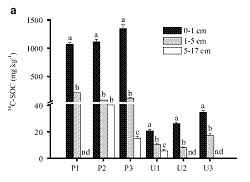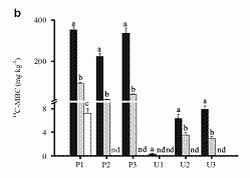自养微生物光合同化碳在土壤不同层次的分布与传输规律分析
由中科院亚热带农业生态研究所主持工作副所长吴金水研究员领衔的农业生态过程方向研究团队近日在土壤自养微生物光合同化碳的层次分布与传输研究方面取得了新进展。相关文章发表于《Applied Microbiology and Biotechnology 》杂志上。


自养微生物光合同化碳在土壤不同层次的分布与传输规律
该团队在前期发现土壤微生物具有可观的碳同化能力的基础上,运用同位素连续标记技术结合分子生物学技术,对土壤自养微生物光合同化碳的层次分布与传输进行了进一步的深入探讨,发现土壤不同层次间的14C-SOC量随着土壤深度的增加而显著减少。第三层5-17cm的底层土壤,有近1/4的土壤未检测到14C的存在,这可能与仅土壤表层很薄的一层能接受光能的原因有关。
这说明土壤微生物的同化作用只发生在表层土壤,但是表层同化碳可以向下传输,传输能力因土壤而异,而且向下传输的同化碳,可能也为底层的化能自养微生物提供碳源和电子供体,从而在一定程度上可能诱导化能自养微生物参与碳同化过程。而且,不同层次间的土壤碳同化关键酶RubisCO酶活性、关键功能基因cbbL数量均随着土壤深度的增加而显著减少,并且稻田土壤的RubisCO酶活性、cbbL功能基因数量亦显著大于旱地土壤。该研究深化了我们对土壤微生物光合同化碳的生物地球化学过程机理的认识。
该研究得到了中国科学院、国家自然科学基金委等项目的资助。
原文摘要:
Changes in bacterial CO2 fixation with depth in agricultural soils
Xiaohong Wu, Tida Ge, Hongzhao Yuan, Baozhen Li, Hanhua Zhu, Ping Zhou, Fanggong Sui,Anthony G. O’Donnell, Jinshui Wu
Soils were incubated continuously in an atmosphere of 14CO2 and the distribution of labeled C into soil organic carbon (14C-SOC) was determined at 0–1, 1–5, and 5–17 cm down the profile. Significant amounts of 14C-SOC were measured in paddy soils with a mean of 1,180.6 ± 105.2 mg kg–1 at 0–1 cm and 135.3 ± 47.1 mg kg−1 at 1–5 cm. This accounted for 5.9 ± 0.7 % and 0.7 ± 0.2 %, respectively, of the total soil organic carbon at these depths. In the upland soils, the mean 14C-SOC concentrations were 43 times (0–1 cm) and 11 times (1–5 cm) lower, respectively, than those in the paddy soils. The amounts of 14C incorporated into the microbial biomass (MBC) were also much lower in upland soils (5.0 ± 3.6 % and 2.9 ± 1.9 % at 0–1 and 1–5 cm, respectively) than in paddy soils (34.1 ± 12.4 % and 10.2 ± 2.1 % at 0–1 and 1–5 cm, respectively). Similarly, the amount of 14C incorporated into the dissolved organic carbon (DOC) was considerably higher in paddy soils (26.1 ± 6.9 % and 6.9 ± 1.3 % at 0–1 and 1–5 cm, respectively) than in upland soils (6.0 ± 2.7 % and 4.3 ± 2.2 %, respectively). The observation that the majority of the fixed 14C-SOC, RubisCO activity and cbbL gene abundance were concentrated at 0–1 cm depth and the fact that light is restricted to the top few millimeters of the soil profiles highlighted the importance of phototrophs in CO2 fixation in surface soils. Phylogenetic analysis of the cbbL genes showed that the potential for CO2 fixation was evident throughout the profile and distributed between both photoautotrophic and chemoautotrophic bacteria such as Rhodopseudomonas palustris,Bradyrhizobium japonicum, Rubrivivax gelatinosus and Ralstonia eutropha.

